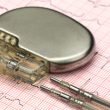The discussion about the best anti-thrombotic strategy for patients with atrial fibrillation undergoing PCI seemed never-ending until the RE-DUAL PCI trial was published in the New England Journal of Medicine (NEJM). This study has arrived to simplify the tough choice between the risk of a thrombotic event vs. the risk of bleeding with a simpler scheme, without<a href="https://solaci.org/en/2017/11/08/the-end-of-aspirin-for-anticoagulated-patients-undergoing-pci/" title="Read more" >...</a>
End of Discussion on the Impact of Pacemaker After TAVR?
Transcatheter aortic valve replacement (TAVR) is often associated with conduction abnormalities, which usually end with permanent pacemaker (PPM) implantation in 10-40% of patients. Factors predisposing to PPM after TAVR have been studied in great detail, but their short- and long-term clinical impact is still controversial. Recently, outcomes from a large cohort of patients were<a href="https://solaci.org/en/2017/10/10/end-of-discussion-on-the-impact-of-pacemaker-after-tavr/" title="Read more" >...</a>
Early Coronary Angiography in High-Risk Non-ST-Elevation ACS
Coronary angiography is essential for patients admitted with non-ST-elevation acute coronary syndrome, since it allows physicians to confirm the diagnosis, stratify the risk, and define the revascularization and antithrombotic management strategies. There is no doubt that these patients should be studied invasively, but the timing for that is still uncertain. Coronary catheterization within<a href="https://solaci.org/en/2017/10/09/early-coronary-angiography-in-high-risk-non-st-elevation-acs/" title="Read more" >...</a>
Is Same-Day Discharge After Angioplasty Safe?
Overnight observation after coronary angioplasty has been the standard of care in the United States. The foundations for this practice go back to the early days of balloon angioplasty, when acute occlusion and access-site complications were frequent. There are several registries and randomized studies showing the clear safety of same-day discharge after coronary angioplasty. This practice<a href="https://solaci.org/en/2017/09/15/is-same-day-discharge-after-angioplasty-safe/" title="Read more" >...</a>
SYNTAX II: Better Stents, IVUS, FFR, or a Combination of All of Them to Catch Up with Surgery
In patients with 3-vessel disease, surgery obtained better outcomes than angioplasty, according to results from the SYNTAX and FREEDOM trials, which used first-generation drug-eluting stents. Even in the BEST trial, which used new-generation stents, surgery still offered far better outcomes. Nobody is surprised by the fact that, whenever angioplasty evolves due to a new device<a href="https://solaci.org/en/2017/09/13/syntax-ii-better-stents-ivus-ffr-or-a-combination-of-all-of-them-to-catch-up-with-surgery/" title="Read more" >...</a>
FOURIER: Efficacy of Evolocumab for Ultra-Low LDL Levels
It seems that a LDL level of 70 mg/dL is no longer low enough for high-risk secondary patients; in consequence, this study attempted to set a new target, one that appears almost impossible to reach: 40 mg/dL or lower. This study, simultaneously presented at the European Society of Cardiology Congress 2017 and published in The Lancet, showed<a href="https://solaci.org/en/2017/09/13/fourier-efficacy-of-evolocumab-for-ultra-low-ldl-levels/" title="Read more" >...</a>
COMPASS: A New Place for Rivaroxaban in Chronic Ischemic Heart Disease
Combining low doses of rivaroxaban and aspirin seems to be the best strategy for patients with stable chronic ischemic heart disease, according to this new study presented at the European Society of Cardiology Congress 2017, which was published simultaneously in the New England Journal of Medicine. Compared with low-dose aspirin alone, the combination of aspirin<a href="https://solaci.org/en/2017/09/07/compass-a-new-place-for-rivaroxaban-in-chronic-ischemic-heart-disease/" title="Read more" >...</a>
Are Bioresorbable-Polymer Stents More Thrombogenic than Durable-Polymer Second-Generation Stents?
Courtesy of Dr. Cristian Jesús Rodríguez. Most stents currently used in percutaneous coronary intervention (PCI) are durable-polymer second-generation drug-eluting stents (DP-DES, with everolimus or zotarolimus). However, it has been argued that the persistence of such a polymer after complete drug elution is one of the main factors for a dangerous complication: stent thrombosis (ST). After<a href="https://solaci.org/en/2017/08/23/are-bioresorbable-polymer-stents-more-thrombogenic-than-durable-polymer-second-generation-stents/" title="Read more" >...</a>
MRS vs. DES: Which one is associated with better long-term quality of life?
The SYNTAX (Synergy Between Percutaneous Coronary Intervention With Taxus and Cardiac Surgery) trial, which included patients with 3-vessel or left main coronary artery lesions, showed that myocardial revascularization surgery (MRS) turned out to be superior to angioplasty with drug-eluting stents (DES), mainly due to differences in acute myocardial infarction and repeat revascularization. Up to this work, patient sensations (which can be<a href="https://solaci.org/en/2017/07/21/mrs-vs-des-which-one-is-associated-with-better-long-term-quality-of-life/" title="Read more" >...</a>
Post DES Dual Antiplatelet Therapy Still under Debate
The NIPPON trial (Nobori Dual Antiplatelet Therapy as Appropriate Duration) was a randomized study comparing a short dual antiplatelet therapy scheme (6 months) vs. a prolonged scheme (18 months) in patients receiving the Nobori drug eluting stent (Terumo, Tokyo, Japan) with a biodegradable abluminal polymer. It included 3,773 patients with chronic stable angina or acute coronary<a href="https://solaci.org/en/2017/07/18/post-des-dual-antiplatelet-therapy-still-under-debate/" title="Read more" >...</a>









